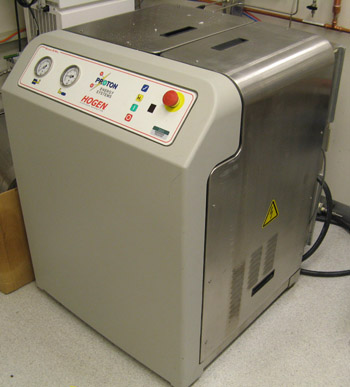Use of an Electrolyzer
Electrolyzer-based hydrogen generators are often used to reduce lab gas inventory by generating hydrogen only as needed. Use of a suitable Electrolyzer/hydrogen generator will allow automated generation on flow/pressure demand.
- To prevent the possibility of having hydrogen pumped into a non-ventilated space, the electrolyzer should automatically shut down if
- there is a ventilation system outage, or
- a laboratory sensor detects hydrogen in the air.
- Use of certified/listed units (e.g., ISO 22734 or IEC 61010-1) is recommended
- Cord-connected bench top appliances typically have very small capacities.
- Direct-wired systems may be specified where a greater capacity is required.
Electrolyzers/ Hydrogen Generators should be installed in accordance with manufacturer’s instructions. General guidance for installation includes:
- Installed in a non-classified area which is ventilated with fresh air.
- Waste hydrogen should be vented to a safe exhaust vent. See Venting.
- Waste oxygen should be either diluted or vented to a safe exhaust vent
- Small units often dilute waste oxygen with enclosure vent air
- Larger units may require oxygen compatible vent piping to a safe exhaust vent
- Interlock with lab alarms – ventilation, combustible gas, fire – to stop hydrogen and oxygen generation
Note that water electrolysis produces oxygen in addition to hydrogen. Special care is needed in handling and disposing of oxygen including specification of piping and component materials, safe venting locations, etc.
References
ISO 22734 – Hydrogen generators using water electrolysis — Industrial, commercial, and residential applications
IEC 61010-1 – Safety requirements for electrical equipment for measurement, control, and laboratory use - Part 1: General requirements


